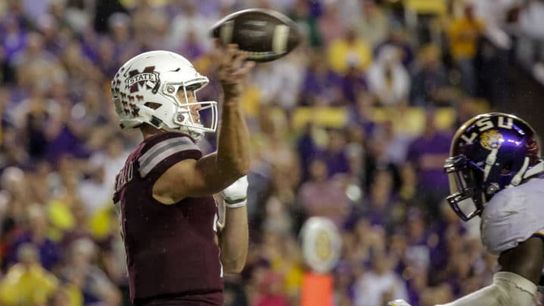A major development in Nov. 3's Alabama-LSU game occurred 14 days before kickoff. In the fourth quarter of Saturday night's LSU-Mississippi State game, Tigers linebacker Devin White was ejected for targeting meaning, by rule, he'll miss the first half of LSU's next game... which happens to be Alabama.
White's crime was captured on camera. Squeamish viewers may want to look away.
LSU AD Joe Alleva has reportedly lobbied the SEC office to remove White's mandatory suspension. It won't work, but it's a commendable, necessary effort. Said the SEC office in response to the play: By rule, no player shall target and make forcible contact to the head or neck area of a defenseless opponent. The QB on the play was defenseless at the time of the contact. By rule, all targeting calls are reviewed. The call was reviewed and confirmed. So White, LSU's best defensive player, will miss half the game against the nation's best offense, while Alabama linebacker Mack Wilson missed zero time for a near identical hit. https://twitter.com/skyeunderwood/status/1053752212772544512?s=21 In September, USC linebacker Porter Gustin remained in the game after this hit.
And, yes, there's a scandalous backstory to why Gustin was allowed to remain in that game, but the two hits underscore the problems with the targeting foul as it's currently legislated in college football. Even if Gustin's hit was correctly ruled as targeting -- as everyone but the Pac-12's top business executive thought it was -- the two hits are still fundamentally different. Gustin launches the crown of his helmet into the quarterback's; White does not. Gustin takes the quarterback to the ground; White does not.
By the letter of the law, White's hit was targeting. Mississippi State quarterback Nick Fitzgerald was in a defenseless position and White (briefly) makes contact with his head. But there was no intent to injure by White. He does not leave his feet and launches himself into Fitzgerald's chest, not his head or neck. The contact upon his head is incidental, not intentional.
The targeting foul as it's currently constructed is not going away. The Powers That Be view it necessary to preserve football's future by legislating head and neck shots out of football. While the penalty isn't going away, it can and should be altered to something like this:
Targeting I: Incidental contact upon the head or neck area of a defenseless player -- 15 yards
Targeting II: Intentional contact upon the head or neck area of a defenseless player -- 15 yards and an ejection
Conferences should also create an appeals process where a Targeting II call can be downgraded to a Targeting I when appropriate. "The rule book says so" is not a justifiable reason to allow an incorrectly, overly harsh penalty to stand.
Targeting will always be a judgment call, up to the interpretation of the referee on the field and the officials in the booth and the command center. But the stakes are such that the professionals involved simply cannot get it wrong and should not be bound by the letter of the law to treat a proverbial misdemeanor (like the White play is) like a felony. An incorrect pass interference flag costs 15 yards. An incorrect targeting flag costs the offender 8 percent of his season.
There's nothing Alleva can do to get White on the field for the first half against Alabama, but the play should be used as an example to prevent Devin Whites from suspensions they don't deserve.
